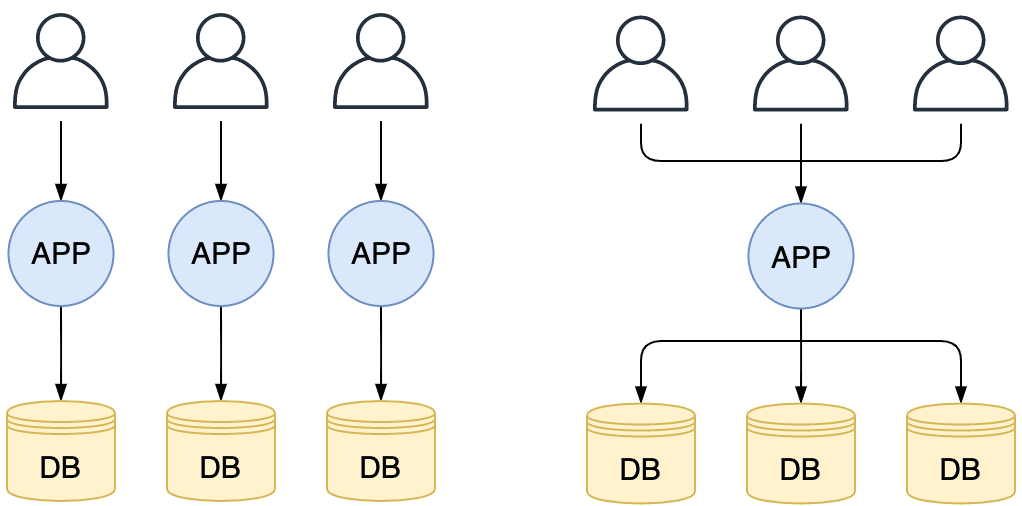What is Single-Tenant and Multi-Tenant?
Single-tenant architecture refers to a single instance of the software and any supporting architecture used to support a single customer or tenant. There is no sharing this instance with any other customers or providers. Any additional customers get their instances that are completely isolated from each other. The host may continue to manage this instance, but the customer has the most control over customizing the software and infrastructure. Generally speaking, because fewer users handle the instance, this offers greater confidentiality, security, backup options, and performance compared to more widely shared software. Naturally, this structure costs more.
By contrast, multi-tenant architecture describes a single software instance, and its architecture runs a single application but is shared between multiple customers or tenants simultaneously. Customer data is kept separate, but everything else is shared, including the infrastructure, codebase, and database. Individual users can still freely adjust database schemas and UI effects and change some of the application’s rules. This structure lowers operations costs by leveraging economies of scale compared to single-tenant environments. With proper scaling, this environment can mitigate the limitations of sharing a single instance with multiple users.
There does exist mixed-tenant architecture where components of an application are dedicated to single users while others parts are shared. This does draw on strengths from the main two architectural structures by sharing resources with as many users as possible, but ensuring that data and some functions are kept isolated.
As an advanced AWS partner, we bring unparalleled expertise to architect, deploy, and optimize cloud solutions tailored to your unique needs.
Strengths and Shortcomings of Single-Tenant Architecture
Having an isolated environment provides much less complexity and data to juggle. Developers will have to worry less about complex scripting and potentially mixing user data during migration. Architecture is inherently similar from instance to instance, making migration easier. Since customers get a dedicated instance, they have free reign to modify it without impacting other customers. By confining all their data to a single instance with no shared users, there is less chance of a data breach, and any data breaches that occur will only affect one customer at a time.
Using single-tenant architecture isn’t the most efficient way to structure a cloud application. As more customers are onboarded, developers must employ additional instances, making management for smaller teams increasingly difficult. With more machines also comes increasing costs of managing multiple units simultaneously. There is no telling how customers will spend their resources, meaning individual instances could go underutilized. The worst case scenario is if the customers use none of the resources provided to them.
Single-tenant solutions do have their advantages, particularly when it comes to control. They offer greater control over resource scaling and maintenance schedules. Dedicated resources can be scaled vertically or horizontally based on specific needs, providing flexibility in resource allocation. This means a business can tailor its resources specifically for their application without worrying about how other tenants might affect performance.
However, this level of control comes with its own set of challenges. As more customers join, the need for additional instances can lead to increased complexity and cost. Smaller teams might find it difficult to manage multiple units simultaneously, especially as the number of machines grows. Moreover, there is a risk of underutilization, where resources provided to individual customers are not fully used, leading to inefficiency.
Strengths and Shortcomings of Multi-Tenant Architecture
Opposite to single-tenant architecture, multi-tenant instances are far easier to manage. With multiple customers using fewer instances, maintenance will take much less time to conduct and, as such, is common practice for many SaaS platforms. Underutilizing resources is less likely because other customers will more likely use resources that some users aren’t using on the same server. With fewer instances to manage and greater frequency with which those resources are used, this architectural method is significantly more cost-efficient.
Multi-tenant architectures benefit from shared resources, allowing for more streamlined scalability and maintenance processes across multiple tenants. This shared resource model enables dynamic allocation, ensuring that resources can be efficiently redistributed to where they are needed most as demand grows. Maintenance processes are also streamlined, as updates and patches can be applied across all tenants simultaneously, reducing downtime and administrative overhead.
Because of its key characteristics, multi-tenant structures are comparatively more vulnerable from a security standpoint since they leave behind many access points suitable for cyberattacks. Because the space is shared, this structure type doesn’t offer as many customization options as single-tenant structures. This lack of customization also means that multi-tenant architecture users have less control over the quality and performance of their environment. With as much that can be attributed to a single environment, tethering resources to multiple users will make tracing extraneous costs more difficult in the long run. These troubles aren’t strong enough to be significant deterrents for this type of system, but they are worth considering.
Which Method is Better?
Though single-tenant is not as cost-efficient as multi-tenant, single-tenant should not be immediately dismissed. Some industries require data protection for compliance requirements, so keeping individual customers isolated is more ideal than keeping costs low. Healthcare and finance handle copious amounts of personal data, and industry regulations like HIPAA mandate patient confidentiality between the customer and the provider. Between companies that need to provide for fewer customers at a time, the difference in operating costs may not be as significant enough to require cost efficiency.
-
Logical Data Separation: This model allows all tenants to utilize a single database. Their data is securely separated through unique identifiers for each client. The codebase retrieves and stores data using these identifiers, ensuring data integrity and security within the same database.
-
Physical Data Separation: Here, different databases are used for clients (tenants). This model facilitates scalability based on each client’s growth, making it easier to manage increasing data loads without compromising performance.
For the majority of the SaaS industry, maintaining a multi-tenant architectural structure will be ideal. Despite potential vulnerabilities, maintaining cost-efficiency for a large number of customers should be more ideal. Because of the nature of the cloud, maintaining fewer instances can also help ease the distribution of maintenance staff. This method is generally the more commonly used structure.
Get Started Today!
At AllCode, our mission is to leverage our unique skillset and expertise to deliver innovative, top-tier software solutions that empower businesses to thrive in our world’s rapidly-evolving technological landscape.
Work with an expert. Work with AllCode



